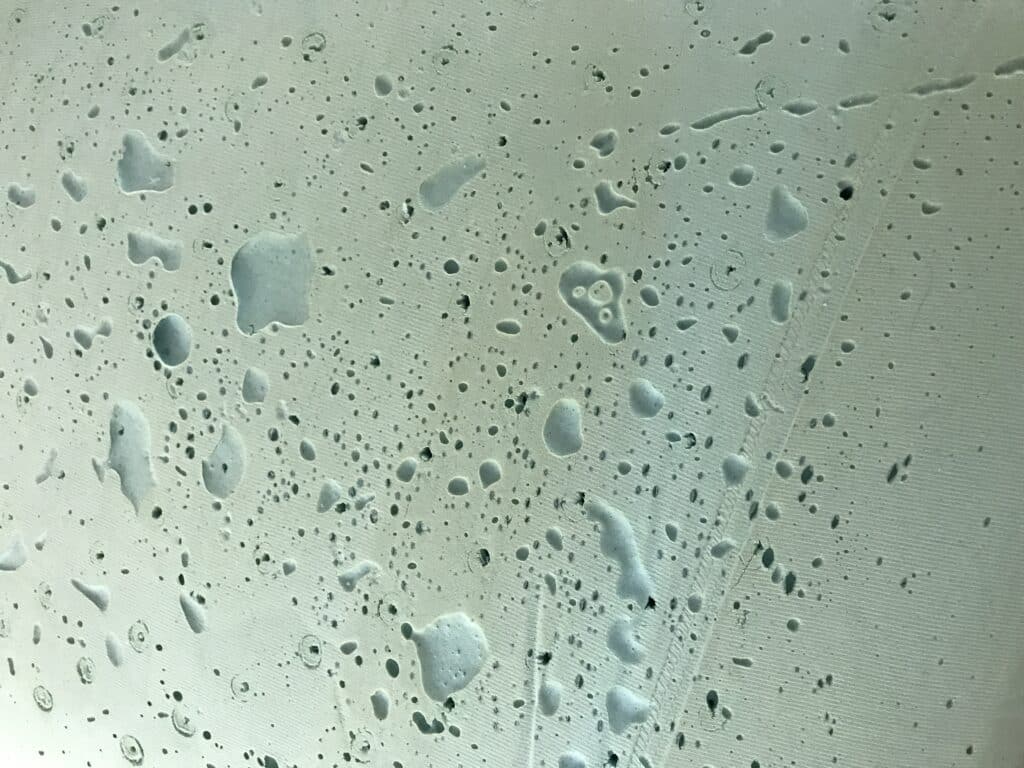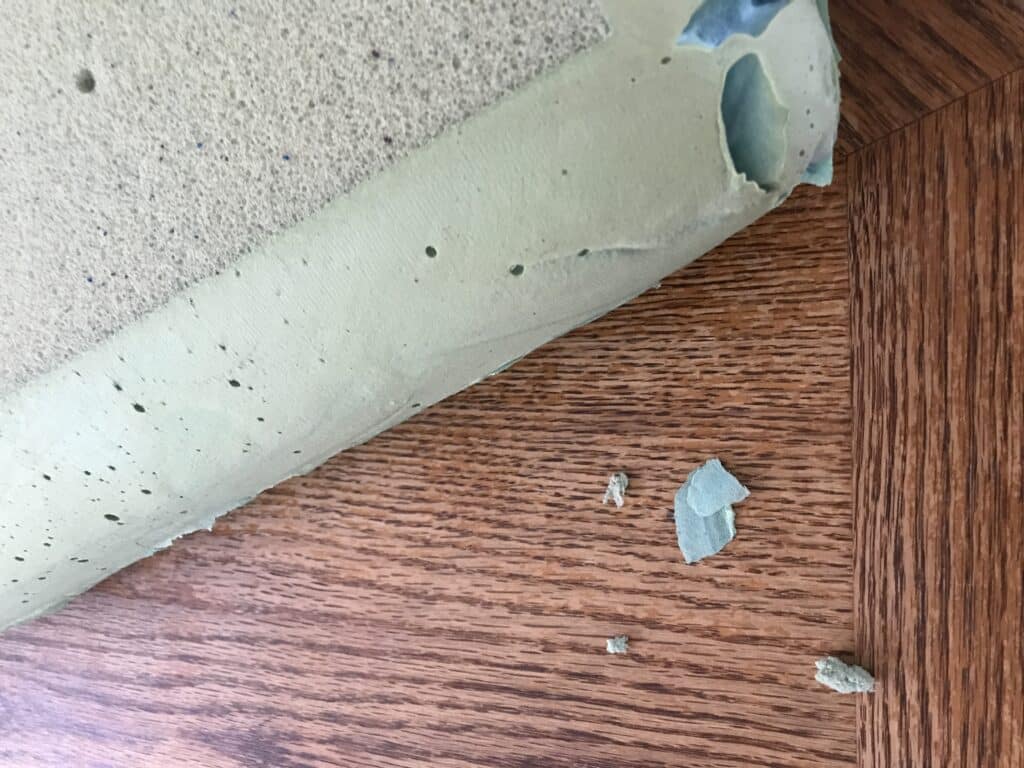Here’s the lowdown on toxic chemicals in pillows and what to watch out for when choosing a new, non-toxic, safe, and sustainable pillow. Spoiler alert: Certipur certification isn’t what it seems.

Table of Contents
Whether your pillow is made with polyester, memory foam, synthetic down alternatives, down itself, synthetic rubber, or conventional cotton, it is very likely off-gassing some nasty chemicals and sabotaging your sleep.
I’ve written extensively at Leaf Score about toxic chemicals in household textiles. Here, I’ll look more closely at the hazardous materials and chemicals in conventional pillows. We also maintain a list of our top picks for organic pillows.
Polyester pillows
Most conventional pillows are made using polyester. This is a mass-produced petroleum-based, nonrenewable resource. Sure, it’s cheap, but at what cost?
Polyester manufacturing:
- Is incredibly energy intensive, which contributes to climate change
- Typically involves coal, air, water, and petroleum
- Requires a plethora of hazardous chemicals, primarily ethylene glycol
- Often takes place in factories with unsafe and unfair working conditions
- Can pollute waterways, the air, and soil
- Takes place primarily in India and China, with most of the oil supplied by Russia.
Ethylene glycol
Ethylene glycol is a toxic chemical that can off-gas from pillows. This means we inhale it as we sleep. It can also be absorbed through our skin and can cause:
- Skin and eye irritation
- Damage to the nervous system and kidneys
- Respiratory irritation.
Polyester pillows make for poor sleep
Polyester doesn’t breathe well, meaning that you’re more likely to overheat, sweat, and have an unpleasant sleeping experience.
Polyester is also very attractive to dust mites as there are plenty of places for these bugs to hide. This means you’ll need to invest in a pillow encasement or regularly wash and dry your polyester pillow to keep it clean.
Finally, polyester pillows have a short life span, getting lumpy and flat within 6-24 months, especially if you go for the really cheap options. This means that millions of polyester pillows end up in landfill or incinerated every year.
It’s rare to be allergic to polyester itself, but this material harbors dust mites and their feces and can worsen allergy symptoms.
Whether you’re wary of the geopolitical impact of buying polyester, the labor ethics, the product quality and longevity, or having hazardous materials and chemicals in your home, it’s clear that polyester pillows are a poor choice compared to safe, sustainable, and natural materials.
Memory foam pillows
Memory foam pillows can offer good support and initially feel very comfortable for most sleepers. However, memory foam is just another name for polyurethane (PU), which can release volatile organic compounds (VOCs) while you sleep.
Like polyester, polyurethane memory foam manufacturing is energy intensive. It also involves formaldehyde and benzene, both of which are bad for factory workers, the environment, and for you and your family. And these pillows degrade fast and furious, churning out toxic dust that you and your family then breathe in.


Find out more about the perils of polyurethane here, as part of the Leaf Score Guide to Mattresses.
CertiPur is a certification made by industry to try to greenwash polyfoam products that are still made with toxic chemicals. Sure, the foam is marginally less terrible than standard memory foam as the certification only applies to polyfoam that is:
- Is free from polybrominated diphenyl ether (PDBE) and some other chemical flame retardants
- Has lower levels of formaldehyde and phthalates
- Has lower levels of some ozone depleting substances, mercury, lead, and other heavy metals.
However, even if it’s CertiPur, memory foam is still resource-hungry, synthetic, and a source of VOCs.
Goose, duck, and chicken down and feather pillows
What’s more natural than a pillow stuffed with feathers and down? As it turns out, quite a few things.
While goose down and feathers are a luxurious stuffing option, making for a soft, indulgent pillow, the ‘natural’ fill is typically sterilized with formaldehyde, bleached, and treated with other hazardous chemicals to reduce their allergenic potential and naturally ‘gamey’ odor.
Down alternative pillows, duvets, and comforters are usually stuffed with virgin or recycled polyester blends.
Feathers and down are also rarely sourced in a humane way. Most are forcibly plucked (repeatedly) from live geese, chickens, and ducks who are reared in cages too small for them to even spread their wings.
There are two main certifications for down and feathers: The Responsible Down Standard (RDS) and Downmark. Of the two, RDS offers the most assurance of less cruelty. Neither certification is particularly robust when it comes to toxic chemical use, however.
Down = the soft material under the breast feathers of geese and ducks. This material helps the birds stay warm in cold weather and doesn’t have sharp quills, which is why it is a popular stuffing for pillows, duvets, and comforters.
Feathers = easier to come by and are often mixed in with down to increase volume.
It takes a lot of down to fill a single pillow, which is why down pillows are so expensive. A grading system marks the ‘fill’ of a down pillow with a number between 300 and 800 to indicate how much space is filled by an ounce of down. The higher the number, the firmer the pillow.
Despite their luxury reputation and price tag, feather pillows can be uncomfortable and unhealthy. Feathers tend to poke through pillows and down and feathers are notorious for collecting dust mites and feces. You’ll also need to fluff down and feather pillows a lot, including during the night, as they lose their loft and flatten very quickly.
Conventional cotton
Whatever the fill material, most pillows have a conventional cotton cover. Some pillows comprise cotton fill and a cotton cover.
Conventional cotton is a resource hungry crop that requires huge inputs of chemical fertilizers, pesticides, and water. Traces of these chemicals can remain in the cotton and end up in your bedding.
In addition, most conventional cotton is bleached using chlorine, which can result in the production of dioxins. These are known carcinogens that pollute waterways and are present in household dust.
Final thoughts
There’s no shortage of toxic materials and chemicals in conventional pillows. Finding one that is natural and non-toxic can be a challenge. Even those made with ‘natural’ materials like cotton, hemp, linen, or latex may be tainted with pesticides and treated with harsh bleaches, dyes, anti-odor treatments, and other chemicals.
Wherever possible, choose pillows made with certified organic materials using safe, non-toxic and environmentally friendly manufacturing processes. This means looking for pillows that carry robust certifications, such as GOTS, GOLS, MadeSafe™, or Made in Green by Oeko-Tex.